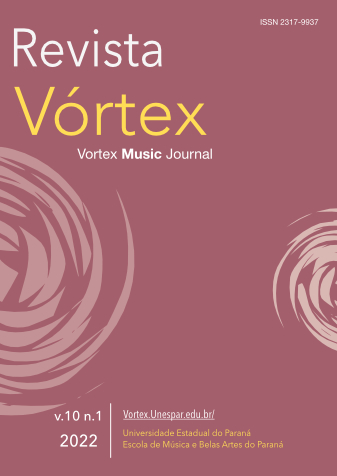Real-time Analysis of Interactive Scores in PWGL
DOI:
https://doi.org/10.33871/23179937.2022.10.1.4Keywords:
computational musicology, soft real-time systems, computer-assisted composition, interactive music notation, music analysisAbstract
In this article, we introduce an original approach to computerized music analysis within the graphical computer-assisted composition environment called PWGL. Our aim is to facilitate real-time analysis of interactive scores written in common Western music notation. To this end, we have developed a novel library that allows us to analyze scores realized with the help of ENP, and to visualize the results of the analysis in real-time. ENP is the native music notation tool of PWGL able to produce automatically typeset and interactive music notation. Here, it is extended to support the display of analytical information that can be drawn on top of the score as an overlay. The analysis backend is realized with the help of our built-in musical scripting language. The language is based on pattern-matching and allows for a rich access of score information. The results of the analysis are presented directly as a part of the original score leveraging the extensible and interactive visualization capabilities of ENP.Downloads
References
BRESSON Jean; AGON Carlos. Visual programming and music score generation with OpenMu-sic. In IEEE Symposium on Visual Languages and Human-Centric Computing, 2011.
HAMEL Keith A. A design for music editing and printing software based on notational syntax. Per-spectives of New Music, Vol. 27, No. 1, 70–83, 1989.
HURON David. Music information processing using the Humdrum Toolkit: Concepts, examples, and lessons. Computer Music Journal, Vol. 26, No. 2, 15–30, 2002.
KUUSKANKARE Mika. Schenkerian analysis tools in ENP. In Proceedings International Com-puter Music Conference, 2013.
KUUSKANKARE Mika; LAURSON Mikael. Intelligent Scripting in ENP using PWConstraints. In Proceedings of International Computer Music Conference, pages 684–687, 2004.
KUUSKANKARE Mika; LAURSON Mikael. ENP Expression Designer – a Visual Tool for Cre-ating User Definable Expressions. In International Computer Music Conference, pages 307–310, 2005.
KUUSKANKARE Mika; LAURSON Mikael. Expressive Notation Package. Computer Music Journal, Vol. 30, No. 4, 67–79, 2006.
KUUSKANKARE Mika; SAPP Craig. Visual Humdrum-library for PWGL. In Proceedings of ISMIR, 2013.
LAURSON Mikael. PWConstraints. In G. Haus and I. Pighi, editors, X Colloquio di Informatica Musicale, pages 332–335, 1993.
LAURSON Mikael; KUUSKANKARE Mika; KUITUNEN Kimmo. Introduction to computer-assisted music analysis in PWGL. In Sound and Music Computing "™05, 2005.
LAURSON Mikael; NORILO Vesa; KUUSKANKARE Mika. PWGLSynth: A Visual Synthesis Language for Virtual Instrument Design and Control. Computer Music Journal, Vol. 29, No. 3, 29–41, 2005.
LAURSON Mikael; KUUSKANKARE Mika; KUITUNEN Kimmo. The Visualization of Com-puter-assisted Music Analysis Information in PWGL. Journal of New Music Research, Vol. 37, No. 1, 61–76, 2008.
LAURSON Mikael; KUUSKANKARE Mika; NORILO Vesa. An Overview of PWGL, a Visual Programming Environment for Music. Computer Music Journal, Vol. 33, No. 1, 19–31, 2009.
NIENHUYS Han-Wen; NIEUWENHUIZEN Jan. LilyPond, a system for automated music en-graving. In XIV Colloquium on Musical Informatics (XIV CIM 2003), 2003.
PUCKETTE Miller. Using Pd as a score language. In Proceedings of International Computer Mu-sic Conference, pages 184–187, 2002.
Downloads
Published
How to Cite
Issue
Section
License
Copyright (c) 2022 Mika Kuuskankare

This work is licensed under a Creative Commons Attribution 4.0 International License.
Autores mantêm os direitos autorais e concedem à revista o direito de primeira publicação, com o trabalho simultaneamente licenciado sob a Licença Creative Commons Attribution que permite o compartilhamento do trabalho com reconhecimento da autoria e publicação inicial nesta revista.






